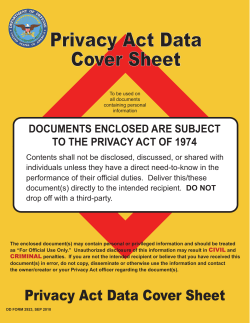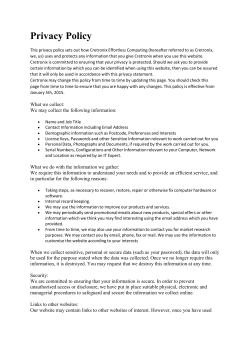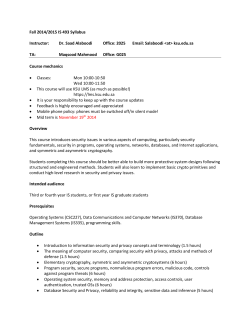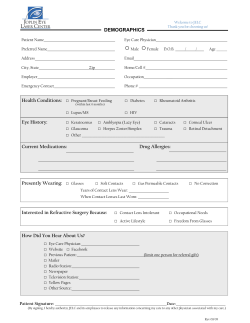
USE DATA TO BUILD, NOT BUST, CUSTOMER TRUST
O N E T O U G H Q U E S T I O N : P R I VA C Y USE DATA TO BUILD, NOT BUST, CUSTOMER TRUST MARKETERS WHO USE CUSTOMER DATA RESPONSIBLY WILL STRENGTHEN CUSTOMER RELATIONSHIPS AND DRIVE SALES. SPONSORED BY Data privacy seems to be an oxymoron today. But it shouldn’t be. Well-managed customer data can lead to all-important customer trust. How important is that trust? According to research from Forbes Insights, 94% of CMOs surveyed say that building trusted customer relationships is critical. Further, 85% assert that data is an important component of building customer trust. And customers are happy to provide data—if there’s a value exchange. A Harris Poll on behalf of Transera Inc. found that 67% of U.S. adults would be willing to give companies access to basic personal information in exchange for better service or products. Indeed, 44% of consumers feel that in the past 12 months they’ve received more relevant offers by sharing more personal data with companies they typically buy from. This begs the question: How can marketers create a virtuous cycle of data acquisition and use that to build rather than bust customer trust? Here, 11 customer data experts give their advice on doing just that. –Ginger Conlon TABLE OF CONTENTS 7 Michael Darviche, Managing Director, Bridge22 César Montes, Global Chief Intelligence Officer and Chief Strategy Officer, Geometry Global - EMEA 8 Ryan Phelan, Email Industry Thought Leader Dennis Daymann, Chief Privacy and Security Officer, ReturnPath 4 Bryan Pearson, President, LoyaltyOne 5 Dave Scott, CMO, Gigya Len Shneyder, Director of Industry Relations, Message Systems 6 Steve Kerho, Chief Strategy Officer, Meredith Xcelerated Marketing 10 Todd Ruback, Chief Privacy Officer, Ghostery 9 Jeff Berry, Research Director, Colloquy Erik Ober, CEO, Booshaka BRYAN PEARSON President, LoyaltyOne @Pearson4Loyalty @LoyaltyOne Only by using data responsibly can marketers build customer trust. Here are five key steps to responsible data use. Be transparent and reasonable. When organizations explain their intentions for data use in straightforward language, and spell out the benefits to the customer, that customer is more likely to engage with the brand. Give customers a choice. Let customers choose how to share their information. Giving them control leads to their buy-in. LoyaltyOne’s AIR MILES Reward Program is permission-based, and 99.99% of customers opt to share their information. Respect and protect data. Collect only the data needed. Use it only as promised and retain it only as long as needed. Avoid personal, creepy areas such as financial information or questions about children. Destroy data with care. Monitor frequency. Brands can stand apart by taking care not to overwhelm customers with too much information. Make sure emails are not too frequent, while being responsive to customers’ needs. Deliver mutual value. Brands must ensure that the data they use delivers recognized value for the customer, as well as for themselves. By value, I do not simply mean the product, cash, points, or coupons. I refer to creating something more powerful: relevancy. DAVE SCOTT CMO, Gigya @Gigya Collecting the data required to deliver more relevant marketing and user experiences without violating privacy and losing customer trust is indeed a privacy paradox. But, increasingly, marketers are turning away from surreptitious data collection methods like data brokering and third-party tracking cookies in favor of other means of understanding their customers—namely, through leveraging customer identity. “Identity” in this context is everything a brand’s customers choose to divulge about themselves—from basic details like their names, email addresses, and ZIP Codes to deeper profile data gleaned from customized registration forms or their social network accounts. By leveraging this accurate, permission-based first-party data to personalize every interaction, brands ensure that customers have greater control over their personal data and privacy, in turn earning their trust. LEN SHNEYDER Director of Industry Relations, Message Systems @LenShneyder @MessageSystems I’m going to borrow a page from Sri Somanchi of Google’s Gmail team, who said there are five R’s he teaches to Google’s internal marketers: 1. Right acquisition 2. Right engagement 3. Right measurement 4. Right adjustment 5. Right opt-out At the heart of these five R’s is the idea that the entire customer relationship needs to be based on trust, and the five R’s are a means of achieving and keeping that trust. Transparency during user acquisition means the relationship starts on the right foot. Measuring user behavior to determine engagement levels is essential. Don’t set it and forget it; reevaluate constantly and adjust what you’re doing with customers’ data and how you’re engaging them. Protect that initial good beginning by limiting the scope of the engagement and safeguarding the data: Don’t sell it, share it, or let it out of your sight. That data was for you and for a specific purpose—let that idea be your guide and ultimate arbiter of what is right and wrong to do with customer data. Additionally, know your market; different geographies have defined what’s possible with customer data in very different terms. What’s legal in a specific geography is highly problematic in another. Let’s remember, just because you can doesn’t mean you should. So, exercise good judgment regardless of where you or your customers are. And finally, don’t be afraid of losing a customer. If the experience of disengagement is painless there’s a chance they’ll return. STEVE KERHO Chief Strategy Officer, Meredith Xcelerated Marketing @SteveKerho @MXMtweets Data collected must benefit both consumers and marketers. The benefits to marketers are obvious: enhanced targeting, effective messaging, and offers that deliver superior performance. The advantages to consumers are often missing from the conversation. To deliver true transparency to consumers, the following elements are required: 1. Consumers should be able to determine what is being tracked about them. 2. Consumers should be able to view the data that is collected about them. While these are simple goals, creating a failsafe process to realize them is another matter. Lack of consumer understanding and sophistication is a key barrier. As marketers we’d do well to place ourselves in the consumer’s shoes. If a tracking, measurement, or targeting program feels creepy, too personal, or intrusive, then it probably is. Just because we can track behavior or draw a specific inference doesn’t mean that we always should. Consumers must have good reason to believe that their data is safe. Without a system that warrants their trust, consumers will inevitably opt out, bringing one of the most powerful Information Age data engines to a grinding halt. As marketers, it’s our responsibility to treat consumer data with the highest levels of respect, transparency, and professionalism that it deserves. Our motivation to protect consumer data shouldn’t simply be to avoid the potential threat of a public backlash; we should do it because it’s the right thing to do. MICHAEL DARVICHE Managing Director, Bridge22 @Digitargeter It’s true that data privacy is largely a concept and not really managed. Regarding consumer activities and thoughts, it’s a wide-open door today. Marketers receive such huge improvements in terms of purchases and ROI from this kind of customer data that it’s unlikely the industry will self-regulate. And with plenty of closed-system marketing platforms (Facebook, et al) capturing this data at scale, marketers have all the more reason to try to keep up. Consumer trust isn’t black and white. It varies from marketing situation to situation. Consumers are implicitly OK with their data being accessed if and when they get real value—emotionally, like access or entertainment, or financially, such as discounts or rewards. Marketers who directly touch consumers around a product or experience can create remarkable data acquisition at scale. Beyond Facebook, game apps are a savvy example. Cleverly, they opt consumers in to agreeing to share contacts, emails, location, and transactional information at the emotional moment of download, and they continue to access behavioral and interest information every day, with every game played. The trust builds for purchasing the next app, because the rewards are positive—and the data risks are sold downstream and not apparent to the user. Consumer trust can continue to build here, via increasing and frequent rewards, group social connection, and the all-important transparent protection of data use and exposure. Marketers can maintain and grow the cycle, using engagement to remind and reconfirm this agreement frequently. CÉSAR MONTES Global Chief Intelligence Officer and Chief Strategy Officer, Geometry Global- EMEA @GeometryGlobal Data is a powerful tool for building customer trust, but only if it’s harnessed to create and deliver messages that are truly relevant to the consumer. Geometry Global’s 2014 Connected Shopper study on global shopping behaviors revealed that while 76% of respondents were concerned about whether companies were handling their personal data responsibly, an almost equal number (75%) was willing to receive relevant communications, offers, and coupons from brands. Even though 43% of those surveyed felt they lacked control over their data trail, as many as 26% of respondents were willing to trade off a degree of privacy to benefit from the full advantages of e-commerce. In other words, when people express concern about how companies handle their data they’re not saying that they want companies to stop communicating with them. People don’t mind brands using their personal profiles to engage them as long as they receive something interesting (right message) and appropriate (right moment and channel). So, the discussion should actually focus on how to find the proper mix of message, moment, and channel to make communication relevant. Marketers must pay greater attention to understanding shoppers’ purchase-decision journey to find the correct points of influence during which communication will be most relevant. This is the key to enhancing the effectiveness and efficiency of brand communications while simultaneously alleviating customers’ privacy concerns. RYAN PHELAN Email Industry Thought Leader @RyanPPhelan More and more companies are going to struggle with the balance between the data they have and their ability to use it. Consumers want a closer relationship with companies that they love and information they can use, but not to the extent that it creates awkward and creepy situations. Companies have to have an internal governance policy for the use of data that determines what data the organization will use for analysis and what it will use for direct communication. This governance changes over time, but at the core keeps the customer relationship as a connection—not, as some have discovered, an intrusion. This is important because as we grow in our technology, information such as real-time behavior data is going to become more accessible. Think about how much data a fitness company collects based on a wearable device. What can that tell a company about individual behavior, especially coupled with third-party demographic/psychographic data? As technology grows, the consumer’s level of trust grows, but the use of that data retreats to those communications that build a relationship and enhance the user’s contextual life. Exceeding that intended use will end up being a violation that will ensure that consumers retreat from providing data. So, when developing a customer strategy, recognize that twist in your stomach. When that happens, step back and evaluate if you’ve crossed the line. Having governing principles will back you up. DENNIS DAYMAN Chief Privacy and Security Officer, Return Path @DDayman @ReturnPath It really comes down to hyper-transparency. Courtesy of the Internet, people everywhere have at their fingertips the most powerful tool ever for finding out what’s really going on and informing others. They’re gaining unprecedented access to all sorts of information about governments, corporations, and other organizations in society—and the same exists for those organizations and corporations that have more data on people than they’ve ever had before. The uptick in breaches isn’t helping the trust we need to build with consumers and the non-permissioned, over-collection, and use of personal data isn’t either. Too many companies are buying data and using it without the notice, consent, and choice of the consumer. Fostering trust between businesses and consumers begins with the business granting choices and control to their consumers, especially concerning its products and services that are being used for data capture. This simple strategy allows businesses to start earning trust from their end-users. Once consumers see repeated respect for their privacy, they’re more likely to provide information to the business. To be honest, I think the idea or confusion behind the term Big Data has caused problems in marketing—and in email marketing in particular. Marketers think that there’s a new set of ideals or processes in place to send email marketing, when in reality the oldest and simplest processes of sending relevant, targeted, and permissioned messaging still stands. When businesses keep a privacy-centric focus, and keep the needs of the end-user in mind, trust is immediately built. JEFF BERRY Research Director, Colloquy @Colloquy When LoyaltyOne surveyed 1,000 U.S. consumers on the data privacy issue, no less than 77% said they don’t feel they’re receiving any benefit from sharing personal information. This survey result underscores that consumers are disappointed and becoming reluctant to share. For years they’ve provided their valuable information and they’re not realizing something of suitable worth in return. Brands need to act quickly to demonstrate that they have the consumer’s best interest at heart or they risk an erosion of the business-to-consumer relationship. There’s encouraging news, too. In the same data privacy survey, 63% of respondents said they’d be willing to give more personal information if companies sent them relevant product and service offers based on the personal data they had provided. Brands that operate loyalty programs should make it a priority to find the sweet spot where relevant engagement meets the need for personal details. ERIK OBER CEO, Booshaka @ErikOber @Booshaka Marketers need a way to improve returns by connecting customer data and making it actionable, but customers are understandably reluctant to share personal data with brands that abuse their trust. Fortunately, there’s a secure solution that allows marketers to create targeting groups on Facebook and Twitter from existing customer email addresses, phone numbers, device IDs, and other data—all without compromising customer privacy. Facebook and Twitter allow marketers to create custom audiences using customer data, and with the right technology, marketers can use their data to deliver more relevant customer experiences while keeping consumer data private. To create custom audiences, marketers can “hash” customer data before it is uploaded, turning it into a short fingerprint that can’t be decrypted. For example, data hashing would turn an email address like “johndoe@example.com” into an encrypted digital fingerprint such as “9a510e527f.” The encrypted data could then be uploaded to Facebook or Twitter securely to create an audience, ensuring that the data is only used to create an audience, then promptly deleted and not shared with other parties. Hashed data is unreadable, even by Facebook or Twitter. By using this technology, marketers can create an audience, deliver a more relevant consumer experience and respect customer privacy. Hashed data delivers a win for everyone, enabling marketers to identify lookalikes and deliver more precisely targeted offers while making sure customer data stays private. That’s how marketers can create a virtuous cycle of delivering value to customers while improving marketing ROI. TODD RUBACK Chief Privacy Officer, Ghostery @CPORuback @GhosteryInc The collection and use of data in new and innovative ways will continue to spur the marketing industry to new heights. However, the business landscape is changing quickly—from the skyrocketing use of mobile as a default screen to interconnected devices, commonly known as the Internet of Things (IoT). Marketing will naturally flow to new business practices based on both, but must do so in a thoughtful way that not only complies with evolving privacy laws and well-established privacy principles, but also in a collaborative way that engenders trust. It’s important because both mobile and the IoT are predicated on massive data collection, which will allow for new uses of data to be devised. The new uses of data, in addition to having potential ground-shifting social benefits, will also drive new channels of revenue. As exciting as the new frontier appears, it comes with huge challenges; in marketing, namely, how to apply old privacy laws and principles to new technologies and uses of data. To bridge the gap, businesses must strive to be open and honest about their data collection and use practices, even as they change and evolve quickly. Transparency is always a good idea, but in the context of mobile and the IoT, marketers who have a well-thought-out transparency strategy will find that privacy is actually a valued process, something that will separate them from their industry peers. Transparency creates a collaborative bidirectional relationship with customers that invests them into the business relationship and serves to empower the consumer, which helps to build brand value and long-term relationships. Transparency always has been a best practice and always will be, regardless of new paradigms.
© Copyright 2025









